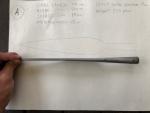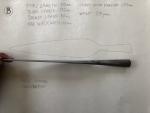10-04-2022, 08:16 AM
About a year and a half ago it was brought to my understanding through a discussion in the Facebook group that there are few sources for getting Greek spearpoints that are correctly constructed and not weighing a ton. I have since figured out a process for forging them in a way that would have been possible back in the days. No drilling out the socket, no welds, and very little waste of material from grinding. I've mostly done them in mild steel lately to be more affordable, but have also done a couple in wrought iron (which is similar to the material used in the past) and spring steel.
For these two the socket is split and butted together. In the past I've spent way too much time forge-welding the sockets (at least partly) but unless for higher end materials, it is just not worth all the effort. Split and butted sockets seem to be quite common in historical examples so it is a perfectly fine solution. These are possibly a bit wide compared to their lengths but I have a couple smaller and narrower (and lighter) in the pipeline.






For these two the socket is split and butted together. In the past I've spent way too much time forge-welding the sockets (at least partly) but unless for higher end materials, it is just not worth all the effort. Split and butted sockets seem to be quite common in historical examples so it is a perfectly fine solution. These are possibly a bit wide compared to their lengths but I have a couple smaller and narrower (and lighter) in the pipeline.







